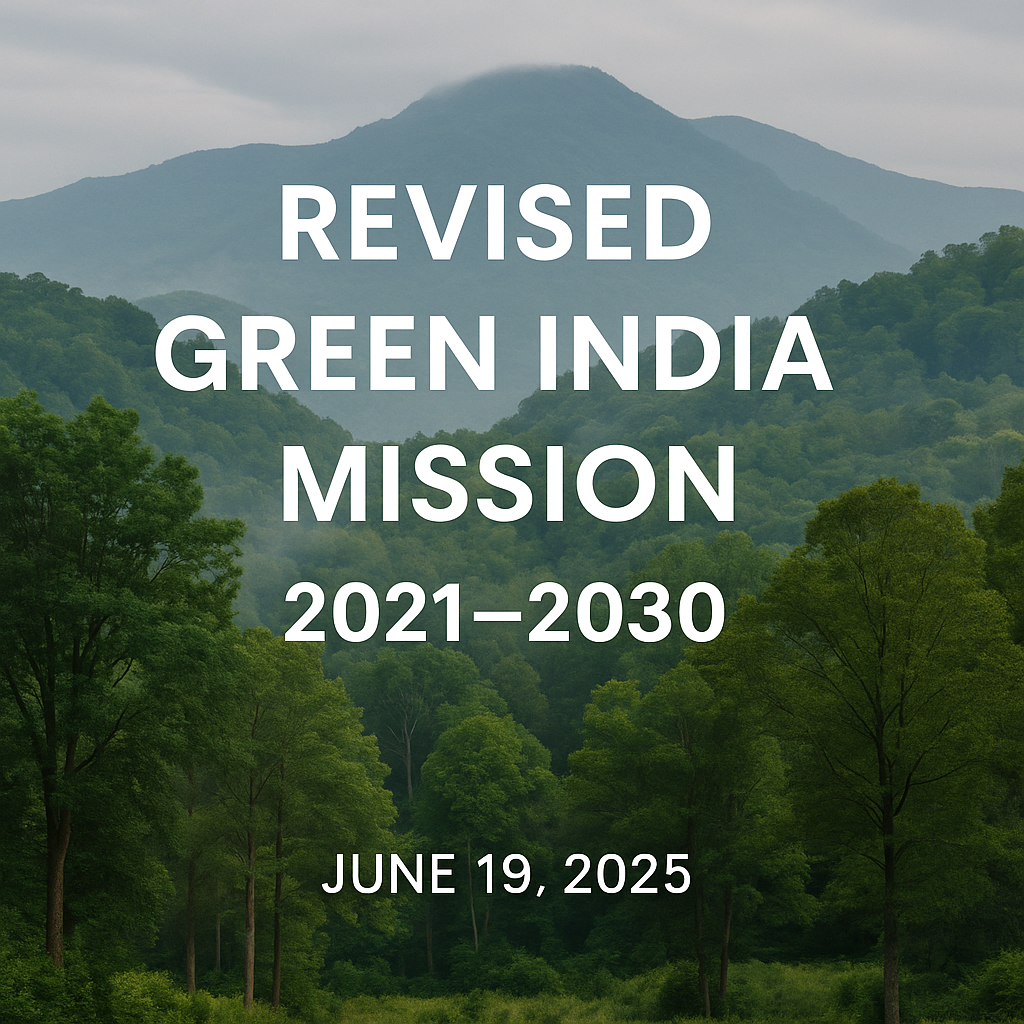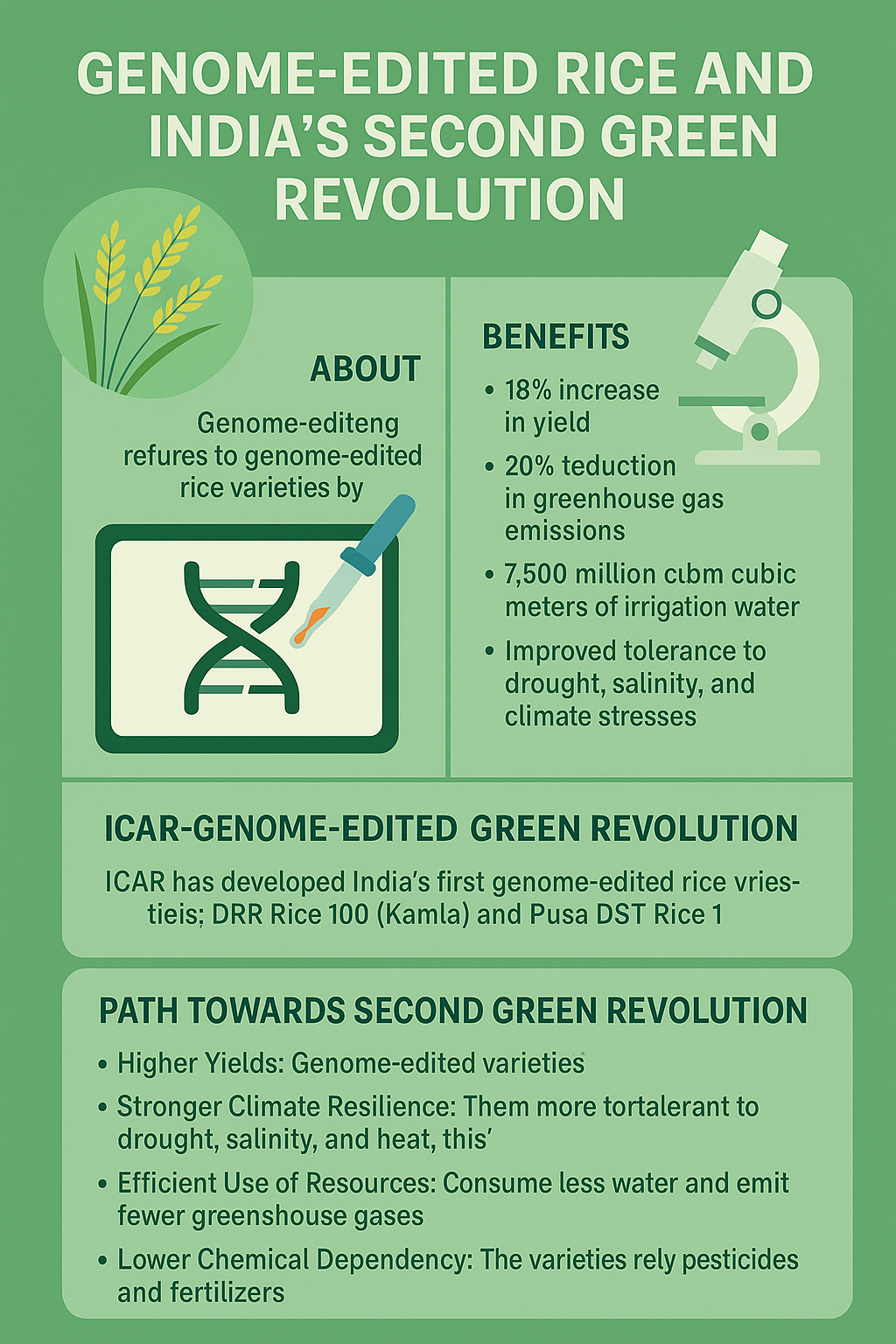
🧭June 19, 2025 Post 1: 🌿The Green Reawakening: India’s Revised Forest Strategy Blooms | High Quality Mains Essay: 🌿 India’s Green India Mission: Planting Roots for a Sustainable Future | For IAS-2026 :Prelims MCQs
The Green Reawakening: India’s Revised Forest Strategy Blooms

🟩 NATIONAL HERO
📅 Post Date: June 19, 2025
📚 Syllabus Mapping: GS Paper 3 – Environment, Climate Change Mitigation
🧭 Thematic Focus
Green India Mission | Forest Restoration | Carbon Sink Targets | Climate Action | Ecological Governance
🌱 Intro Whisper
In a world battling the climate crisis, India plants not just trees — but resolve. The Revised Green India Mission isn’t just a policy, but a promise rooted in the soil of sustainability.
🌲 Key Highlights
🔸 Revised GIM Plan (2021–2030) released by Union Environment Minister Bhupender Yadav sets an ambitious roadmap for forest restoration and carbon sink enhancement.
🔸 Mission Origins: Launched in 2014 as part of the National Action Plan on Climate Change (NAPCC); one of the 8 core missions.
🔸 Core Targets:
- Increase forest/tree cover on 5 million hectares of forest and non-forest land
- Improve forest quality on another 5 million hectares
- Create 2.5 to 3 billion tonnes of CO₂ equivalent carbon sink
🔸 Updated Forecasts:
- As per FSI, full implementation could yield 3.39 billion tonnes CO₂ equivalent
- 24.7 million hectares of coverage needed to meet target
🔸 Micro-Ecosystem Approach adopted for restoration in vulnerable regions:
- Aravallis
- Western Ghats
- Himalayas
- Mangroves
- Arid zones of Northwest India
🔸 Tree Plantation Models:
- Open forest recovery
- Agroforestry
- Degraded land plantation
- Green belts along railways and highways
🔸 Governance Structure:
- National Governing Council chaired by Environment Minister
- National Executive Council led by Environment Secretary
🔸 Achievements so far:
- Since 2015–16, 11.22 million hectares restored through field-level activities
- Annual plantation trend (~2 million ha) indicates future momentum
📘 GS Paper 3 Mapping
Topic: Conservation, Environmental Pollution and Degradation, Environmental Impact Assessment
Subtopics:
- Climate change adaptation and mitigation strategies
- Forest restoration and carbon sink initiatives
- Governance and policy implementation in environmental missions
🍃 A Thought Spark — by IAS Monk
“To plant a tree is to believe in a future you may never see. But to restore a forest is to echo the wisdom of generations lost — and found again.”
High Quality Mains Essay For Practice :
Word Limit 1000-1200
🌿 India’s Green India Mission: Planting Roots for a Sustainable Future
Introduction
As the world teeters on the edge of a climate emergency, India has unveiled its revised roadmap for one of its most ambitious environmental schemes — the Green India Mission (GIM). Introduced under the National Action Plan on Climate Change (NAPCC), the mission stands as a testament to India’s commitment to restoring ecological balance while contributing to its international climate pledges. The updated GIM for 2021–2030 reimagines India’s landscape not merely as a swathe of green but as a dynamic and resilient ecosystem, rooted in community participation and guided by science-backed planning.
The Genesis and Vision of the Green India Mission
Launched in 2014, the Green India Mission was one of the eight key missions under the NAPCC. Its aim was not merely afforestation in the conventional sense but ecosystem restoration — to protect, enhance, and rejuvenate forests and non-forest green cover through a climate adaptation and mitigation strategy. Unlike earlier plantation drives that focused on tree count, the GIM emphasized biodiversity, ecological services, and community livelihoods, integrating development with conservation.
The revised GIM seeks to build upon this foundation. With updated targets and a sharper vision aligned to India’s Paris Agreement goals, the mission aspires to add an additional carbon sink of 2.5 to 3 billion tonnes of CO₂ equivalent, a formidable challenge given the demands of rapid urbanization, developmental pressure, and climate stress.
Revised Goals and the Science of Scale
According to the revised plan, the mission intends to increase forest and tree cover over five million hectares and improve the quality of forest cover on another five million hectares. The targets are ambitious but grounded in recent ecological assessments.
The Forest Survey of India’s latest projections suggest that if restoration efforts are carried out in full spirit, India can create a carbon sink of 3.39 billion tonnes of CO₂ equivalent. However, to meet this enhanced goal, the mission would need to extend restoration to nearly 24.7 million hectares, a substantial leap from the original 10 million hectare target. This signals a profound strategic shift from modest plantation targets to landscape-level ecological recovery.
Micro-Ecosystems and Region-Specific Restoration
A core strength of the revised GIM lies in its “micro-ecosystem approach” — a departure from a one-size-fits-all plantation strategy. This approach recognizes the unique challenges of each vulnerable landscape:
- The Aravalli Hills, scarred by mining and urban sprawl
- Western Ghats, teeming with endemic species but under threat from encroachments
- Northwest India’s arid regions, where desertification looms
- Mangrove ecosystems, vital for coastal protection
- The fragile Indian Himalayan Region, already showing signs of ecological stress
Each of these regions requires tailored restoration, considering their soil health, water availability, native species, and community practices. The mission’s alignment with this ecological granularity reflects its scientific maturity.
Implementation Strategies and Innovations
To meet its targets, GIM 2.0 will harness both conventional and innovative tools. Among its major strategies:
- Restoration of open and degraded forests using assisted natural regeneration techniques.
- Agroforestry promotion on private lands to combine livelihood and conservation.
- Urban and peri-urban tree planting, along highways, railways, and wastelands.
- Use of geospatial mapping, satellite imagery, and AI-driven monitoring systems to track progress.
- Incorporation of climate-resilient species, rather than exotic, fast-growing monocultures that degrade local ecosystems.
Furthermore, FSI analysis has shown that India’s best opportunity for carbon sink creation lies in the forests degraded in the last 15–20 years. The focus will thus be on reclaiming these transitional lands, bridging the gap between ecological memory and future resilience.
Mission Governance: A Vertical Integration
The revised plan also overhauls governance mechanisms. It introduces a three-tiered institutional structure:
- National Governing Council chaired by the Union Environment Minister
- National Executive Council led by the Secretary, Ministry of Environment
- Mission Directorate comprising experts in forestry, climate science, and restoration ecology
States will play a crucial role, with State Forest Departments, Panchayati Raj Institutions (PRIs), Joint Forest Management Committees (JFMCs), and local communities participating in planning and implementation. The revised document stresses gender inclusion, ensuring that women’s Self-Help Groups and local Mahila Mandals are embedded in mission activities.
Progress So Far: A Mid-Mission Evaluation
Field-level interventions under GIM began in 2015–16. By 2020–21, approximately 11.22 million hectares of land had been covered under various plantation and restoration schemes. However, several reviews pointed out issues of patchy implementation, data inconsistencies, and lack of convergence with related schemes such as CAMPA funds, MGNREGS, and NABARD-supported agroforestry projects.
The revised plan integrates learnings from this phase, promising better convergence with state action plans, community-led monitoring, and robust financial planning.
Climate Commitments and Global Perception
India’s updated Nationally Determined Contributions (NDCs) under the Paris Agreement highlight the GIM as a cornerstone of its carbon sequestration strategy. The nation has already achieved its 2030 target of reducing emissions intensity by 33–35% of 2005 levels — a feat globally recognized.
Through the revised GIM, India is positioning itself not just as a responsible stakeholder in global climate discourse but as a leader of the Global South that shows how ecological restoration can be socially inclusive and economically viable.
Challenges and Road Ahead
Despite its noble goals, the path is fraught with real-world constraints:
- Land availability remains a major bottleneck, especially with competing demands from agriculture, industry, and housing.
- Survival rate of plantations has been an issue in previous campaigns; long-term maintenance mechanisms must be embedded.
- Funding clarity remains ambiguous. While the Environment Ministry is the nodal agency, financial convergence with rural development, tribal affairs, and state governments needs streamlining.
- Community ownership and benefit-sharing are critical to success, especially in tribal belts and forest fringe villages.
The mission’s success will ultimately depend on whether it can transform tree planting into forest regeneration, and community involvement into ecosystem stewardship.
Conclusion: Sowing the Future
The Revised Green India Mission marks a visionary shift in India’s environmental planning. It is not merely about planting saplings but cultivating consciousness — one that sees forests as living systems intertwined with human well-being, biodiversity, and planetary health.
If implemented with sincerity, scientific rigor, and community participation, GIM can become India’s living legacy for future generations. As the monsoon nourishes the soil, may this mission nurture the spirit of green growth, rooted in the brown earth and reaching up toward a blue sky of hope.
Target IAS-26: Daily MCQs :
📌 Prelims Practice MCQs
Topic: The Green Reawakening: India’s Revised Forest Strategy Blooms
MCQ 1 – Type 1: How many of the above statements are correct?
Consider the following statements regarding the Revised Green India Mission (GIM):
1. The mission aims to increase forest and tree cover over 10 million hectares of land.
2. It is one of the eight core missions under India’s National Action Plan on Climate Change (NAPCC).
3. GIM is primarily focused on creating a carbon sink of 1.5 billion tonnes of CO₂ equivalent.
4. The revised plan includes a micro-ecosystem approach for vulnerable landscapes like Aravallis and Western Ghats.
How many of the above statements are correct?
A) Only one
B) Only two
C) Only three
D) All four
🌀 Didn’t get it? Click here (▸) for the Correct Answer & Explanation
✅ Correct Answer: C) Only three
🧠 Explanation:
•1) ✅ True – The combined target includes 5 million hectares for new forest/tree cover and 5 million hectares for improving degraded cover.
•2) ✅ True – GIM is indeed one of the 8 missions under NAPCC.
•3) ❌ False – The correct carbon sink target is 2.5 to 3 billion tonnes of CO₂ equivalent, not 1.5 billion.
•4) ✅ True – The revised plan includes micro-ecosystem approaches for specific ecologically fragile zones.
MCQ 2 – Type 2: Two Statements Based
Consider the following statements:
1. The Forest Survey of India has projected that India can create a carbon sink of over 3 billion tonnes if restoration activities are fully implemented.
2. Under the revised GIM, tree plantations are excluded from urban and wasteland regions to focus on natural forest zones.
Which of the above statements is/are correct?
A) Only 1 is correct
B) Only 2 is correct
C) Both are correct
D) Neither is correct
🌀 Didn’t get it? Click here (▸) for the Correct Answer & Explanation
✅ Correct Answer: A) Only 1 is correct
🧠 Explanation:
•1) ✅ True – FSI has projected that India could create a carbon sink of 3.39 billion tonnes of CO₂ equivalent.
•2) ❌ False – Tree plantations are explicitly included in urban areas, wastelands, and along highways and railway lines under the revised GIM strategy.
MCQ 3 – Type 3: Which of the statements is/are correct?
Which of the following statements are correct regarding the Revised Green India Mission (2021–2030)?
1. It introduces region-specific restoration plans for vulnerable ecological zones.
2. Implementation will be overseen by the National Executive Council chaired by the Prime Minister.
3. The mission integrates geospatial mapping and AI-based monitoring.
Select the correct code:
A) 1 and 2 only
B) 1 and 3 only
C) 2 and 3 only
D) 1, 2 and 3
🌀 Didn’t get it? Click here (▸) for the Correct Answer & Explanation
✅ Correct Answer: B) 1 and 3 only
🧠 Explanation:
•1) ✅ True – A micro-ecosystem approach is adopted for places like Aravallis, mangroves, Himalayas, etc.
•2) ❌ False – The National Executive Council is chaired by the Environment Secretary, not the PM.
•3) ✅ True – Technology tools like AI and remote sensing are part of GIM’s revised implementation strategy.
MCQ 4 – Type 4: Direct Fact
Under the Revised Green India Mission, which of the following targets is correct?
A) Increase tree cover over 20 million hectares
B) Generate 5 billion tonnes of carbon sink by 2030
C) Improve forest quality on 5 million hectares of land
D) Restore wetlands and marine ecosystems as the primary goal
🌀 Didn’t get it? Click here (▸) for the Correct Answer & Explanation.
✅ Correct Answer: C) Improve forest quality on 5 million hectares of land
🧠 Explanation:
•C) ✅ True – The mission targets improving forest quality on 5 million hectares, alongside increasing tree cover on another 5 million hectares.
•A) ❌ False – Total targeted area is ~10 million hectares under core GIM goals.
•B) ❌ False – The carbon sink target is 2.5 to 3 billion tonnes.
•D) ❌ False – Wetlands and marine restoration are not part of the Green India Mission’s primary objectives.


















